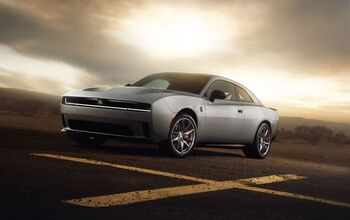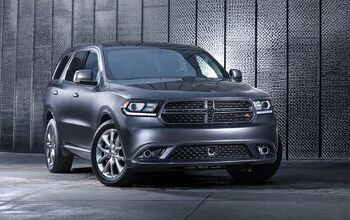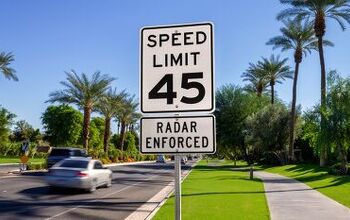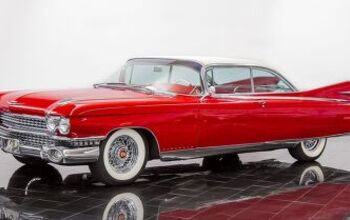The Replacement for Displacement: Plotting Our Path Out of the Malaise Era

Around the time of the Bicentennial, 300 horsepower was reserved for from-the-factory supercars and custom builds aimed at the drag strip. Today, you can find family sedans eclipsing that benchmark without a lot of trouble. Compare the first decade of Toyota Corollas to hit North American shores to their modern day equivalents and you’ll note that 0 to 60 time have been almost halved.
It’s the same with most models. A few years ago, I had the privilege of driving a well-maintained 1977 Oldsmobile Omega and wondered how enthusiasm ever survived malaise era automobiles. It must have been the gorgeous styling keeping us going.
Modern cars aren’t just more powerful, they’re also far more efficient and significantly less dirty. Additional safety regulations and standard equipment should have left us with bogged-down fuel hogs, yet automakers have managed to roll with the punches — not just maintaining the status quo but routinely moving it forward. However, to really appreciate just how far we’ve come you need to see those decades of progress plotted.
Authors at Bloomberg — who must have had some extra time on their hands this week — have done just that. Drawing data from forty years of Environmental Protection Agency emission testing, they plotted the U.S. light vehicle fleet’s path to glory. The results are dramatic.
Probably the most incredible takeaway from the findings is how much median acceleration has increased along side average economy. The EPA graphs — which you should definitely check out — highlight how much things have changed. Sitting at a tortoise-like 16-plus seconds at the dawn of the 1980s, 0-60 times have since shrunk to a median of 7.2 seconds in 2016. Since the end of the Ford administration, fuel economy has tripled, and median engine displacement has dipped from roughly 5.2 liters to 3 liters.
From Bloomberg:
“Combustion engines on America’s roads are about 42 percent smaller than they were 40 years ago. At the same time, the EPA’s median measurement of miles-per-gallon has doubled, from 15 to 30. Most of those gains were made under pressure from federal efficiency mandates. The great power push began in 1985 just after the industry had hit a threshold of 27.5 miles-per-gallon.”
Drivetrain enhancements chug along nicely for about twenty years after that, but things really get going around 2007, when engineers collectively realized they could mitigate efficiency loss while continuing to add power. Direct injection and cylinder deactivation were major leaps forward while manufacturers perfected variable valve timing, forced induction, cooling systems, and lightweight materials.
Those advancements took us from 1976 — where a 285 horsepower Aston Martin V8 was the best anyone in the U.S. could possibly achieve — to 2017, where your neighbor’s base model Ford Taurus is rated at 240 hp. All of a sudden, there arrived a bevy of higher output motors requiring less time at the pump and tiny econoboxes with triple-digit power specs.
It turned out there was a replacement for displacement, after all.
“Today, we can model it, we can visualize it, and we can make sure the fuel ends up in the air, not on the cylinder wall,” said Prabjot Nanua, director of General Motors’ advanced engine and racing engineering.
I know we all miss unadulterated classics like the Mercury Bobcat, Chevrolet Corvette 305 California, and Ford Mustang II. By all measurements, those were nearly perfect automobiles. However, sometimes it’s nice to appreciate what you have today and give a nod to the past for helping you get there.
[Image: RL GNZLZ/ Flickr ( CC BY-SA 2.0)]

A staunch consumer advocate tracking industry trends and regulation. Before joining TTAC, Matt spent a decade working for marketing and research firms based in NYC. Clients included several of the world’s largest automakers, global tire brands, and aftermarket part suppliers. Dissatisfied with the corporate world and resentful of having to wear suits everyday, he pivoted to writing about cars. Since then, that man has become an ardent supporter of the right-to-repair movement, been interviewed on the auto industry by national radio broadcasts, driven more rental cars than anyone ever should, participated in amateur rallying events, and received the requisite minimum training as sanctioned by the SCCA. Handy with a wrench, Matt grew up surrounded by Detroit auto workers and managed to get a pizza delivery job before he was legally eligible. He later found himself driving box trucks through Manhattan, guaranteeing future sympathy for actual truckers. He continues to conduct research pertaining to the automotive sector as an independent contractor and has since moved back to his native Michigan, closer to where the cars are born. A contrarian, Matt claims to prefer understeer — stating that front and all-wheel drive vehicles cater best to his driving style.
More by Matt Posky
Latest Car Reviews
Read moreLatest Product Reviews
Read moreRecent Comments
- Lou_BC Well, I'd be impressed if this was in a ZR2. LOL
- Lou_BC This is my shocked face 😲 Hope formatting doesn't fook this up LOL
- Lou_BC Junior? Would that be a Beta Romeo?
- Lou_BC Gotta fix that formatting problem. What a pile of bullsh!t. Are longer posts costing TTAC money? FOOK
- Lou_BC 1.Honda: 6,334,825 vehicles potentially affected2.Ford: 6,152,6143.Kia America: 3,110,4474.Chrysler: 2,732,3985.General Motors: 2,021,0336.Nissan North America: 1,804,4437.Mercedes-Benz USA: 478,1738.Volkswagen Group of America: 453,7639.BMW of North America: 340,24910.Daimler Trucks North America: 261,959


































Comments
Join the conversation
I actually agree with Denver Mike. Many of the foreign cars especially German and British cars from the 70's were not that great from a reliability and performance standpoint. A well tuned V-8 in most domestic cars were very reliable and provided good performance. One of the best running and performing cars I have ever owned was a 73 Chevelle with a 350 V-8 which would easily lay rubber and would run smooth at 100 mph. Of course it did not have a catalytic converter but even my 77 Monte Carlo with a 305 V-8 was not too bad but it was not as good as the 350. I do prefer the fuel injection and the safety features of today's cars over the past but a well tuned V-8 from the 70's was very good and would easily run well over 100k without any major mechanical issues. Most V-8s from the 70's were fairly easy to tuneup and the points were not that hard to adjust after you did it a few times. By the mid 70's most cars had electronic ignitions and were fairly easy to maintain. The worst thing was by the 80's many carburetors were electronically controlled and were hard to keep them running decently. Fuel injection is much better than those electronic controlled carburetors.
It goes both ways. Today's cars have much different problems compared to the 70's and 80's stuff. Back then it was carburetor rebuilds, points to adjust or replaced until electronic ignition, belt and hose replacement every so many years and rust. One also needed to spend more time adjusting rear brake drums, adjusting the valve lash on an old Chevy V8, replace valve cover and intake gaskets and transmissions needed band adjustments in addition to service. Fuel mileage was often bad to poor. Drive-ability was terrible on many Chrysler era Lean Burn equipped cars and others offering tiny choking 1BBL setups. With that said those older cars usually rode like a dream and bumps were filtered right out of the cabin in full framed or larger unibody cars. V8 engines provide smooth quiet power and were generally reliable and gave years of service. Depending on the era they could also provide reasonable good power. Trunks were very big with large openings. Windows were mounted with low site lines giving great visibility. Interiors offered numerous color choices and exterior styling on many vehicles was eye catching with lots of chrome and flash. The stick shift transmission was offered generally across the board on most models save really large luxury sedans and full sizers and the customer had a bewildering choice of body styles ranging from 2 doors with pickup beds, coupes, personal luxury coupes, sedans, hatches, pony cars, sporty coupes, station wagons and trucks. There were even large full size SUV's in the form of the Bronco and Blazer but with only 2 doors. Conversely those older 70's and 80's cars had terrible 4 cylinder engines in many applications that were loud, slow as hell and had miles of vacuum lines snaking around trying to keep the pain in the but carburetor happy. Turbo technology sucked with the draw thru design fed by PITA carburetor and fuel economy was poor on even many 4 banger engines. These were also experimental times with oil sucking rotary engines, variable displacement engines that didn't have the computing power or reliability we have today, mixed metal engines that leaked like sieves, variable venturi carburetors and lean burn systems that refused to run correctly and a multitude of other quality control related problems. Fast forward to today and reliability is considerably better for the most part but still not perfect. Instead of carburetors and higher levels of things that need service we have annoying touch screens and controls, poor visibility, small trunk openings, boring or just plain outrageous styling, interiors that totally lack color and charm and big chasms of body styles that used to be offered. It is also very hard to order a vehicle today exactly the way you want to. Often times the consumer is forced into expensive option packages just to get a leather steering wheel or fog lamps or navigation. Power and driveability are worlds better but some of the modern transmissions do not shift well or as smooth as they did 10-15 years back. With today's sad obsession with large trucks and SUV's there are a full range of 4 door pickups and SUV's and CUV's galore but the main sellers are hum drum frumpy 4 cylinder CUV's like the RAv 4 and CRV. Choices for the car enthusiast are fading however with the rapid demise of the stick shift and sporty coupes and sedans like the Chevy SS and the soon to be gone Taurus SHO. Also lost are Oldsmobile, Pontiac, Saab, Hummer, Mercury and Plymouth to name a few. Somewhat redundant brands but divisions like Pontiac often did build exciting vehicles.